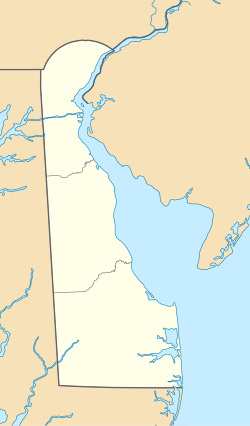
Hockessin is a census-designated place (CDP) in New Castle County, Delaware, United States. The population was 13,478 at the 2020 Census.

New Castle is a city in New Castle County, Delaware, United States. The city is located six miles (10 km) south of Wilmington and is situated on the Delaware River. As of 2020, the city's population was 5,551.

The Diocese of Wilmington is a Latin Church ecclesiastical territory – or diocese, of the Catholic Church in the eastern United States. The diocese comprises the entire state of Delaware and the Eastern Shore Region of Maryland. The Diocese of Wilmington is one of three dioceses that spans two states or districts.
This is a list of properties on the National Register of Historic Places in northern New Castle County, Delaware.

St. James Episcopal Church, Mill Creek, also known as St. James Church or St. James Church, Stanton, is an historic Episcopal church located at 2106 St. James Church Road, in Stanton, Mill Creek Hundred, New Castle County near Wilmington, Delaware.
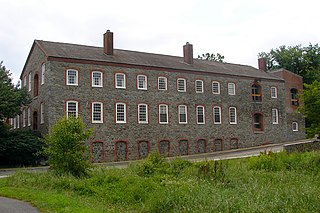
Rockland is an unincorporated community in northern New Castle County, Delaware, United States. It lies along Rockland Road north of the city of Wilmington, the county seat of New Castle County. Its elevation is 194 feet (59 m). It has a post office with the ZIP code of 19732. The Rockland Historic District and William Young House are listed on the National Register of Historic Places. Other landmarks Woodley Park and Mount Lebanon United Methodist Church.

The Springer Farm is a historic farm located at Hockessin, New Castle County, Delaware. The property includes four contributing buildings. They are a stone house, a stone and frame bank barn, a stone spring house, and a braced frame corn crib, both dated to the 19th century. The house is a two-story, gable-roofed, fieldstone structure on a coursed fieldstone foundation.

Hockessin Friends Meetinghouse is a historic Quaker meeting house and national historic district located at 1501 Old Wilmington Road in Hockessin, New Castle County, in the U.S. state of Delaware. The district encompasses three contributing buildings and one contributing site. It was added to the National Register of Historic Places in 1973.
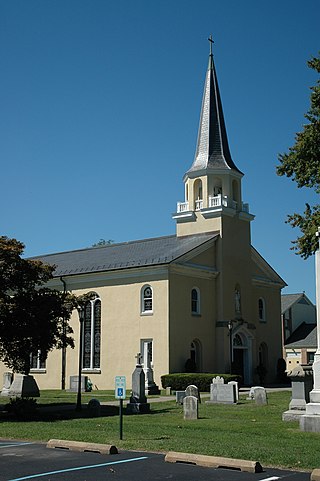
St. Joseph on the Brandywine, originally Saint Joseph's Church until St. Joseph's Church- Wilmington was built in 1947, is a parish of the Roman Catholic Church in Greenville, New Castle County, Delaware, in the Diocese of Wilmington. It is a historic parish church complex and national historic district located on Old Church Road. Since 2002 its old convent building has housed the diocesan archives, with records going back two centuries. It is also the home parish of the 46th President of the United States, Joe Biden.
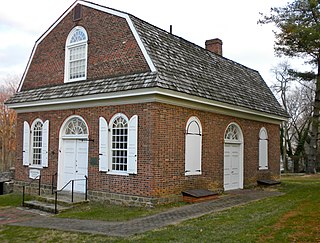
Old First Presbyterian Church of Wilmington is a historic Presbyterian church located on West Street on Brandywine Park Drive in Wilmington, New Castle County, Delaware.

Friends Meetinghouse is a historic Quaker meeting house at 4th and West Streets in Wilmington, Delaware in the Quaker Hill neighborhood. The meeting is still active with a membership of about 400 and is part of the Philadelphia Yearly Meeting. It was built in 1815–1817 and added to the National Register of Historic Places in 1976.

Mount Lebanon Methodist Episcopal Church, also known as Mount Lebanon United Methodist Church, is a historic Methodist Episcopal church located at 850 Mount Lebanon Road in Wilmington, New Castle County, Delaware. It was built in 1834, and is a stuccoed stone structure in a Late Gothic Revival style. It measures 60 by 40 feet, and has a steep gable roof and frame vestibule added in 1873. Adjacent to the church is a contributing cemetery containing approximately 150 tombstones dating from 1840.

Mount Pleasant Methodist Episcopal Church and Parsonage is a historic Methodist Episcopal church and parsonage located at Wilmington, New Castle County, Delaware. It was built in 1838, and is a one-story, stuccoed stone structure with a gable roof. It measures approximately 50 feet by 40 feet, and has a gable-roofed vestibule added in 1893. Adjacent to the church is the parsonage built in 1894. It is a 2+1⁄2-story, four-bay L-shaped frame dwelling in the Queen Anne style. It sits on a fieldstone foundation and features gray-green fish-scale shingles. Adjacent is the contributing church cemetery with burials dating back to 1841.

The T. Pierson Farm is a historic farm located at Hockessin, New Castle County, Delaware. The property includes three contributing buildings. They are a stone house with late-19th century frame addition, a stone and frame bank barn, and a mid-19th century frame outbuilding. The house is a two-story, two-bay, gable-roofed building that is constructed with rubble fieldstone. It has a two-story, three-bay, frame wing to form a five-bay main facade. The barn features a pyramidal-roofed cupola with louvered sides atop the gable roof.

The A. Armstrong Farm was a historic farm located at Hockessin, New Castle County, Delaware. The property included two contributing buildings. They were a log house with a stone addition added in the 1830s, and a frame tri-level stone and frame barn. The stuccoed log section was three bays wide, and it had a two-story, two bay stone wing. The farm house and barn were demolished before 2002.

J. McCormack Farm was a historic farm located near Wilmington, New Castle County, Delaware. The property included four contributing buildings. They were a stone house, a stone and frame bank barn, storage building, and corn crib. The house was a two-story, gable-roofed, stuccoed stone structure with a two-story rear wing. The barn walls were of semi-coursed fieldstone finished with a pebbled stucco.
Louviers, also known as Upper Louviers and Black Gates, was a historic home located at Wilmington in New Castle County, Delaware.

Breck's Mill Area, also known as Breck's Mill Area-Henry Clay Village Historic District, is a national historic district located along Brandywine Creek in unincorporated New Castle County, Delaware, near Wilmington. It encompasses 56 contributing buildings, five contributing sites, and three contributing structures. The district encompasses The Mill, The Workers' houses, and The Mill Owner's Home.

The Beaver Valley Rock Shelter Site is the only formally recognized cave in the US state of Delaware. It is located in New Castle County near Wilmington and the state line with Pennsylvania.
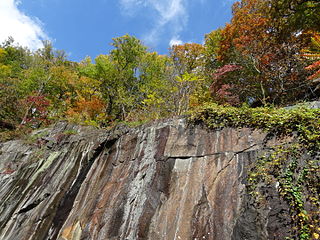
Alapocas Run State Park is a state park, located in Wilmington, Delaware, United States, along the Brandywine Creek and its Alapocas Run tributary. Open year-round, it is 415 acres (168 ha) in area. Much of the state park was created from land originally preserved by William Poole Bancroft in the early 1900s to be used as open space parkland by the city of Wilmington as it expanded. The park also includes the Blue Ball Barn, a dairy barn built by Alfred I. du Pont as part of his Nemours estate in 1914. In addition to walking trails, athletic fields, and playgrounds for children, one of the park's primary features is a rock climbing wall. The rock climbing wall is part of an old quarry across from historic Bancroft Mills on the Brandywine, and the quarry is also used for school educational programs centered on earth sciences.

